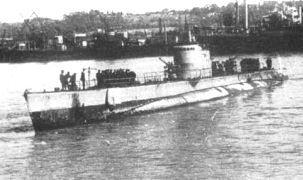

|
U-Boats in the Far East
Italian Transport Submarines - Aquila and Merkator
At a Naval Conference on February 20 1943, Grossadmiral Donitz, who was newly appointed Grand Admiral of the Kriegsmarine briefed Adolf Hitler about the unacceptably high losses of German surface ships transporting war materials to and from the Far East. During that conference, Donitz suggested that the large Italian submarines were unsuitable for warfare in the Atlantic and that they should be converted for transport duties to the Far East.
Codenamed Aquila, the plan called for ten Italian submarines operating out of Bordeaux to undergo a six weeks conversion program, which by then they could carry up to 150 tons of cargo. They were still manned by Italian crews and in exchange for their ten Atlantic boats, the Germans provided ten new Type VIICs to the Italian Navy. Hitler gave his approval but in the event, two were sunk during their homeward journey, leaving only eight for conversion. The two that were sunk were the Archimede (April 16 1943) off the Brazilian coast and the Leonardo da Vinci (May 24 1943) in the Bay of Biscay.

|
| The Italian Archimede was sunk before it could be converted. |
The first three sailed in May 1943, followed by two more in June. Each submarine carried stores of ammunition, including spare torpedoes, blueprints and other materials vital to establish a U-boat base. These submarines sailed in advance of Gruppe Monsun, the planned first wave of German U-boats destined for the Far East, and in part was to provide the necessary provisions to replenish the operating boats. Another two Italian submarines were preparing to leave Bordeaux and the final boat was still at sea when the Italian armistice was announced. With the Italian surrender, the operation was renamed to Merkator.
Of the eight transports, only three managed to reach Singapore in July and August 1943. Their mission was to ferry supplies back to Germany. However, not one made it back to Europe. A summary of their operations is described below.

|
| One of the submarines converted for transport role, the Italian Alpino Bagnolini. She was renamed to UIT-22 under German command.
Photo credits:- www.regiamarina.net/subs/submarines/bagnolini/bagnolini_it.htm |
Operational History
Five submarines departed Bordeaux in May and June 1943. They are the Reginaldo Giuliani (Aquila II), Commandante Cappellini (Aquila III), Luigi Torelli (Aquila VI), Barbarigo (Aquila V) and Enrico Tazzoli. Of the five, two were sunk en route; the Barbarigo was sunk on June 19 1943, probably by aircraft off the Azores and the Enrico Tazzoli disappeared on May 22 1943, cause and location unknown. The remaining three submarines arrived in Singapore between July and August 1943. As Italy’s surrender seemed imminent, the Japanese grounds all three submarines.
Meanwhile, another two submarines were preparing to leave Bordeaux. The Giuseppe Finzi and Alpino Bagnolini were also both grounded by the Germans, also due to the imminent Italian surrender.
September 9 1943, the Italians surrendered. The last boat for conversion, Ammiraglio Cagni, was still at sea and the Italian crew surrendered to the British at Durban, South Africa. The Japanese seized the three submarines at Singapore, but after some negotiations, they were handed over to the Germans.

|

|
| The Enrico Tazzoli was the first submarine to be lost, after having lost contact on May 22 1943. | Engine problems kept the Finzi (UIT-21) in port. She never left European waters and was scuttled on August 1944. |
Photo credits:- www.regiamarina.net/subs/submarines/finzi/finzi_it.htm
Under the Germans, the operation was changed to Merkator and the submarines were given new designations. The three boats in Singapore became UIT-23 (ex-Giuliani), UIT-24 (ex-Cappellini) and UIT-25 (ex-Torelli). The two boats at Bordeaux were renamed UIT-21 (ex-Finzi) and UIT-22 (ex-Bagnolini).
The two boats at Bordeaux attempted to sail to the Far East, but the UIT-21 was riddled with engine defects and finally scuttled in August 1944. The UIT-21 never left Bordeaux. Meanwhile the UIT-22 departed Bordeaux on January 26 1944. En route to round the Cape of Good Hope, she was damaged in an aircraft attack off the Ascension Islands and lost a lot of fuel. As a result, the U-178 which was homeward bound to France was ordered to rendezvous with UIT-22 for a refueling operation some 600 nautical miles southwest of the Cape of Good Hope. The U-178 having recently replenished from the tanker Charlotte Schliemann was also to collect a new radar warning device and Enigma keys from UIT-22.
Having broken the German Naval Code, the British knew all about the rendezvous operation through intercepted messages. They were however hesitant to attack for fear of arousing German suspicions that their communications were no longer secure. But when U-178 sent a long radio message on March 5, which was picked up and DFed (direction fixed) by the South African Navy, the British decided that it was safe to attack. On March 8 1944, British and South African aircraft found and attacked U-178, but she managed to elude the attackers. Then on March 11, a British Catalina aircraft while searching for U-178 had found UIT-22 instead. Several more Catalinas were directed to the scene and in a surprise coordinated attack, the UIT-22 was sunk with all hands off Cape Town.

|
| British submarine HMS Tallyho torpedoed and sank the Reginaldo Giuliani (UIT-23) in the Straits of Malacca on February 14 1944. |
Of the original eight Italian submarines, only three remained, which were UIT-23, UIT-24 and UIT-25 in Singapore. The UIT-23 would be the next victim. On February 13 1944, she departed Singapore and made for Penang. On the next day, February 14, the British submarine HMS Tallyho torpedoed and sank her in the Straits of Malacca, off the Malayan Peninsula.
The last two surviving Italian submarines, the UIT-24 and UIT-25 had the most fascinating careers, which took the crew halfway around the world, to Japan and with no sure way of getting home. The UIT-24 attempted to return to Europe on February 8 1944. Laden with 115 tons of rubber, 55 tons of tin, and 10 tons of other materials, including quinine, the plan was for her to replenish from the tanker Charlotte Schliemann in the Indian Ocean before proceeding round the African Cape and back to Europe. But after the tanker Charlotte Schliemann was sunk on March 11, the replenishment was tasked to the tanker Brake. When the Brake was also sunk on March 12, the U-532 was sent to replenish the UIT-24. Insufficient fuel and coupled with engine problems however, forced the UIT-24 to return to Penang, where she arrived on May 4 1944. Having unloaded her stores, she sails for Kobe, Japan for an engine overhaul. The UIT-25 follows suit shortly after. The overhauls were complete by August 1944, but with the network of tankers destroyed, the crew found themselves stranded in Asia with no way of getting home. The two submarines were put to good use however, ferrying goods between Southeast Asia and Japan.
When Germany surrendered on May 10 1945, the two boats were undergoing overhauls in Kobe, Japan. With the surrender, the German flag was lowered and in its place, the Japanese flag was raised on the conning tower. The UIT-24 was commissioned into the Japanese Navy as I-503 and UIT-25 as I-504. These two submarines were the only two submarines which flew all three flags of the Axis powers of the Second World War.
Their final fate. Both I-503 and I-504 was scuttled by the US Navy on April 16 1946 in Japan.

|
| The Italian Cappellini was one of the two submarines which flew all three flags of the Axis powers.
Photo credits:- www.regiamarina.net/others/fareast/fareast_us.htm |
Fate of the Italian Boats
Of the eight transport boats, only three reach the Far East, while the remainder were either sunk, scuttled, or surrendered. Of the three that made it, one was sunk in the Straits of Malacca and the other two eventually served under the Japanese and surrendered with the war's end. Not one succeeded in ferrying the much needed supplies back to Germany.
| Fate of the Italian Boats | |||||
| Original Name | Under Italian | Under German | Under Japanese | Depart | Fate |
| Reginaldo Giuliani | Aquila II | UIT-23 | - | Bordeaux, May 1943 | Arrives at Singapore, July 26 1943
Commissioned as UIT-23, Sep 10 1943 Sunk by HMS Tallyho, Feb 14 1944 in Straits of Malacca |
| Commandante Cappellini | Aquila III | UIT-24 | I-503 | Bordeaux, May 11 1943 | Arrives at Sabang (Sumatra), July 9 1943
Departs Sabang, July 10 1943 Arrives at Singapore, July 13 1943 Commissioned as UIT-24, Sep 10 1943 Commissioned as I-503, May 10 1943 Surrendered at Kobe, Aug 30 1945 Scuttled by US Navy, Apr 16 1946 |
| Enrico Tazzoli | Aquila I | - | - | Bordeaux, May 16 1943 | Sunk May 22 1943, location unknown |
| Luigi Torelli | Aquila VI | UIT-25 | I-504 | Bordeaux, Jun 14 1943 | Arrives at Sabang (Sumatra), August 26 1943
Arrives at Penang, August 29 1943 Arrives at Singapore, August 31 1943 Commissioned as UIT-25, Sep 10 1943 Commissioned as I-504, May 10 1943 Surrendered at Kobe, Aug 30 1945 |
| Barbarigo | Aquila V | - | - | Bordeaux, Jun 16 1943 | Sunk June 19 1943, off Azores |
| Giuseppe Finzi | - | UIT-21 | - | Never departed | Scuttled July 25 1944, France |
| Alpino Bagnolini | - | UIT-22 | - | Bordeaux, Jan 26 1944 | Sunk Mar 11 1944, off Cape Town |
| Ammiraglio Cagni | - | - | - | - | Surrendered to the British Sep 9 1943, Durban (S. Africa) |
Next: Gruppe Monsun Boats



